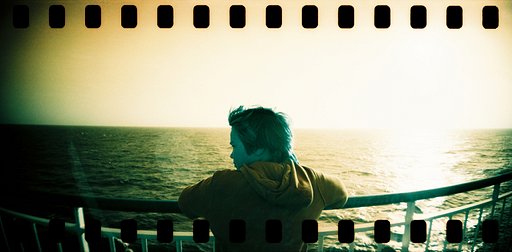How to Shoot LomoChromes at Night
13 18 Share TweetThanks to Lomography the world can experiment again with the magic of color-shifting films. But how does one use these films properly in different lighting conditions? Here are some tips about shooting with the LomoChrome Purple and LomoChrome Turquoise at night.

Choosing the Perfect Place
I am a Brazilian analog photographer and my area of expertise is colors. I have a strange extracorporeal connection with pigments and I became obsessed about relating everything in my work with it. I wanted to try my experiment in a place that was full of light sources and color information for a good basis, so the traveling amusement park that was passing through my city was the perfect choice. If you have a lot of streets with neon lights in your city or a public carousel or even cool Christmas decor, do not fear to try it out--just follow the lights. These photos were made in November of 2016 on a hot summer night (the summer in Brazil is sweltering!), for a better understanding of what the climate conditions the film was used in. If you have different color results in other climate or temperatures conditions at night go ahead and share the results in the comments!

Nighttime Guide on ISO
LomoChromes have a tolerance line between 100 to 400 but their sensitivity to night shoots is not as sharp in color, so consider ISO 100 and speeds ranging from 1/2 to 1/4 or the probability of underexposure will be huge. The lower the photometry of the ISO, the brighter the colors will be, but maintain the rationality and not metering the LomoChrome film below ISO 25 with extremely low speeds because the light sources can emanate a great number of waves and end up mixing all the colors, resulting in a sea of blurred whites. The same goes for photometries of shooting at higher ISO than 400 with very low speeds. Always remember: Whenever a film is photometrically outside the original coverage area, it is important that such data be compensated on the developing process.

Turquoise at Night
Although equally beautiful, LomoChromes have very different color results, so keep this in mind when you’ll choose the color composition of your photos.

Lomochrome films are simulated infrared media and may not have the same sensitivity to temperature, climate, and proper gear as the original infrared films, but they have the same characteristic in terms of color shifting. Depending on the chemical composition of the surface to be photographed and the physical reflection of lighting, there may be different color effects, especially if the angulation and frequency of the light rays are changed. To better understand such effects it's interesting that we look at some photos of the park in real colors and then in a turquoise and purple simulation.

If the main subject of the photo is a colored light source, consider the following possibilities:
LomoChrome Purple
Purple and dark blue – bluish green
Orange – pink variations
Pink and light purple – yellow
Midtone blue – bluish green
Green - purple
Yellow – pinks and light purple
Bright red – stays red (other red variations it tends to turn into red-brownish or red-orangish tones)
LomoChrome Turquoise
Midtone blue – mustard
Pink – muddy purple
Violet – warm orange
Reds, greens and yellows – dark blue/bright blue/ turquoise blue/emerald green/bright violet

In the reviews All About the Blues: A LomoChrome Turquoise XR 100-400 Film Review and LomoChrome Purple XR: How to Get that Purple are great guides on how to deal with color variations for other surfaces in daytime situations, but take certain precautions when the subject is light, especially at night.
Note that the color palette of Lomochrome Turquoise is much stricter than that of the Lomochrome Purple but there is not such great tolerance in terms of colors when you are searching for color palettes with lights. The luminous color spectra react according to the magnitude of the material surrounding the light, for example, colorful glasses from neon lights, plastic capsules from Christmas decor lights, car headlights, etc. So, if you expect a light source to reliably respond to a color based on composition and refracting surfaces other than those used in lighting make sure your result will not be as expected.

In terms of light, understand that very dark shades, browns, grays, and even black, will not be possible to achieve, the perceived maximum is darkened colors in the shifting process (unless other tones are generated by waves of differentiated kinds of light, such as black light). The use of bulb with controlled apertures (from 4.9 to 5.6) or screen cross filters can extend the light trajectories, making other tones and bringing small rainbows to the photos.
So, how will you compose your next night wonderland?
My entire “LomoChromes at Night” shoot album can be found here.
written by Júlia Brümmer on 2017-02-11 #gear #night-photography #lomochrome-purple #lomochrome-turquoise



















13 Comments